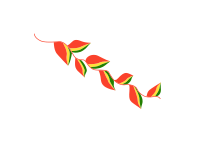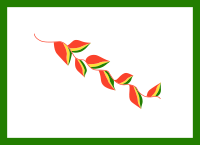Flag of the Patujú flower facts for kids
 |
|
| Use | Civil flag and ensign normal |
|---|---|
| Proportion | 8:11 |
| Adopted | 2013 (Santa Cruz Department) 2014 (Beni Department) 2018 (La Paz Department) 2019 (officially adopted by national government) |
| Design | Patujú Flower in 45° degrees |
| Designed by | Adolfo Chávez Beyuma Antonio Soto Guatara |

Variant flag of the Patujú flower
|
|
| Use | popular version in Santa Cruz |
The flag of the Patujú flower (Spanish: Bandera de la flor de patujú) is an important symbol in Bolivia. It is used in official government events and proudly displays Bolivia's national flower, the patujú. This flag especially represents the native communities living in Eastern Bolivia. It has also been used to show support for different ideas in the country.
History of the Flag
The idea for the Patujú flower flag grew stronger around 2011 and 2012. At that time, many people were protesting against building a road through a special area called the Indigenous Land and Isiboro-Secure National Park (TIPNIS). The patujú flower became a symbol for Eastern Bolivia during these protests.
Becoming an Official Symbol
Even though the flag was seen in demonstrations, it wasn't officially recognized at first. It didn't have a specific design used by the government. However, things began to change:
- In 2013, the flag started to be used in the Santa Cruz Department.
- In 2014, it was adopted in the Beni Department.
- By 2018, the La Paz Department also began using it.
Finally, in 2019, the Patujú flower flag was officially adopted by the national government of Bolivia. This meant it could be used alongside other national flags in important events. During the time when Jeanine Áñez was leading the government, the flag was often seen next to other state flags in official buildings and ceremonies. It was given a new, special design for these events.
See also
 In Spanish: Bandera de la flor de patujú para niños
In Spanish: Bandera de la flor de patujú para niños

